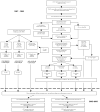The Queensland Study of Melanoma: environmental and genetic associations (Q-MEGA); study design, baseline characteristics, and repeatability of phenotype and sun exposure measures
- PMID: 18361720
- PMCID: PMC3677021
- DOI: 10.1375/twin.11.2.183
The Queensland Study of Melanoma: environmental and genetic associations (Q-MEGA); study design, baseline characteristics, and repeatability of phenotype and sun exposure measures
Abstract
Cutaneous malignant melanoma (CMM) is a major health issue in Queensland, Australia, which has the world's highest incidence. Recent molecular and epidemiologic studies suggest that CMM arises through multiple etiological pathways involving gene-environment interactions. Understanding the potential mechanisms leading to CMM requires larger studies than those previously conducted. This article describes the design and baseline characteristics of Q-MEGA, the Queensland Study of Melanoma: Environmental and Genetic Associations, which followed up 4 population-based samples of CMM patients in Queensland, including children, adolescents, men aged over 50, and a large sample of adult cases and their families, including twins. Q-MEGA aims to investigate the roles of genetic and environmental factors, and their interaction, in the etiology of melanoma. Three thousand, four hundred and seventy-one participants took part in the follow-up study and were administered a computer-assisted telephone interview in 2002-2005. Updated data on environmental and phenotypic risk factors, and 2777 blood samples were collected from interviewed participants as well as a subset of relatives. This study provides a large and well-described population-based sample of CMM cases with follow-up data. Characteristics of the cases and repeatability of sun exposure and phenotype measures between the baseline and the follow-up surveys, from 6 to 17 years later, are also described.
Figures


References
-
- Aitken J, Welch J, Duffy D, Milligan A, Green A, Martin N, Hayward N. CDKN2A variants in a population-based sample of Queensland families with melanoma. Journal of the National Cancer Institute. 1999;91:446–52. - PubMed
-
- Aitken JF, Green AC, MacLennan R, Youl P, Martin NG. The Queensland Familial Melanoma Project: study design and characteristics of participants. Melanoma Research. 1996;6:155–65. - PubMed
-
- Australian Institute of Health and Welfare. Australasian Association of Cancer Registries. 2004.
-
- Cancer in Australia. Australian Institute of Health and Welfare. Australasian Association of Cancer Registries; Canberra: 2001.
-
- Bashir SA, Duffy SW. The correction of risk estimates for measurement error. Annals of Epidemiology. 1997;7:154–64. - PubMed
Publication types
MeSH terms
Grants and funding
LinkOut - more resources
Full Text Sources
Medical
Molecular Biology Databases

